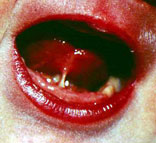Overview:

Ankyloglossia, otherwise known as tongue-tie, is the partial or full attachment of the tongue to the bottom of the infant's mouth. Tongue-tie causes a significant portion of of the problems encountered with breastfeeding. It also is thought to pose other short term and long term complications, such as speech impediments, problems with swallowing, and the formation of teeth arrangement. There is some controversy over the defining characteristics of tongue-tie as well as the treatments.
